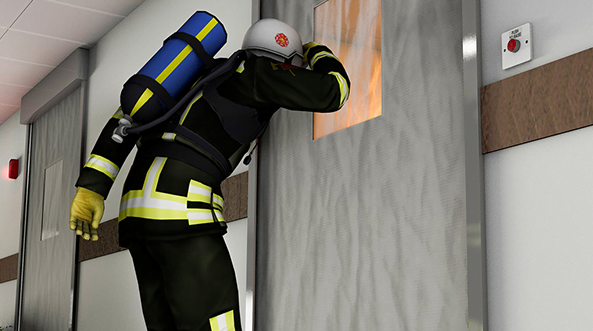The simplest definition of a fire curtain is a long-lasting piece of fire-resistant material that hangs from a ceiling, lobby, or entranceway until a smoke or fire alarm is triggered in the structure, at which point it is dropped. As a result, during an emergency evacuation, the curtain acts as a barrier between the fire and the escape routes used by building occupants. It’s vital in this case to contain the flames and keep them from spreading laterally or vertically, increasing the risk to people’s safety.
As a safety measure, the use of fire curtains has the added benefit of allowing them to be installed in a variety of locations around the facility. Non-load bearing walls and fire rated windows, for example, can be replaced with fire curtains. This enables open-plan building designs to adhere to the necessary regulations while still retaining their aesthetically pleasing characteristics. Additionally, vertical curtains can be utilised to protect elevators and lobbies from the spread of smoke and fires in the shaft.
Because of its physical barrier properties, a fire curtain can be an effective way to keep occupied spaces and evacuation zones safe from the flames. However, these restrictions must be taken into account during the design phase.
When the curtain is deployed, first responders and building residents will no longer be able to look into the area where the fire started. It can be difficult to tell if someone is trapped in an area where they are in danger.
When fighting a fire, first responders may benefit from being able to see its size and nature. This could be useful to them. The presence of a fire curtain makes this difficult without breaching the curtain or temporarily elevating it above the ground… Despite these limitations, a fire curtain-equipped structure is far more secure than one without one.
When properly constructed, a see-through fire curtain removes the issues presented by an opaque product by allowing building occupants and first responders to see through the curtain once it has been deployed.
Fire curtain systems may easily be adapted to work with it, making it an excellent choice for places like elevator lobbies, doorways, and corridors along escape routes.
On-going maintenance
International standards designed particularly for this purpose must be followed while specifying, installing, and maintaining fire curtains and smoke curtains. FMs who are in charge of overseeing the safe operation of their building are at risk of being entirely caught off guard in the event of a fire because of the general ignorance of standards.
The National Fire Protection Association (NFPA) 80 standard is used by designers and contractors when designing fire doors and other opening guards, as issued by the National Fire Protection Association. This standard governs how a fire curtain is installed and maintained. There are two sections to this article, the first published in 2013 and focusing on fire curtain specifications and installation and maintenance following the installation of the fire curtain. If we lived in an ideal world, we’d have a much better understanding of these criteria, which would allow us to install only the highest-quality equipment and maintain them properly so they last as long as possible.
Most facility managers (FMs) believe they will never have to deal with fire curtains in their careers because of the importance of “out of sight, out of mind” that both NFPA 80 and BS 8524 place on routine maintenance. But when people realise that their way of thinking is at odds with what’s considered best practise, they develop a bad attitude.
Barrier assemblies should be inspected, tested, and maintained on a regular basis to ensure they are working properly and efficiently. It is required by BS 8524 that these tests be carried out by a “competent person who is able to verify and validate that barrier assemblies are running and working satisfactorily, as needed,” and that all of these tests must be properly documented and registered.
The National Fire Protection Association (NFPA 80) states that only a competent building owner or property manager should conduct these inspections. A “qualified person” is someone who has shown the ability to deal with the subject, work, or project through the possession of a recognised degree or certificate as well as professional standing or expertise as defined by the National Fire Protection Association (NFPA) (NFPA 80). Additionally, it is this person’s responsibility to retain records for future use.
This form of upkeep necessitates a few different things. This method is described in full in NFPA 80, from installation and testing all the way through to “modification of opening protectives.” In order to verify that fire curtains meet all applicable requirements and laws, building occupants should conduct regular risk assessments. Other checks should be done to make sure the fire curtain can deploy without being obstructed.
In accordance with British Standard 8524, building occupants are required to check their premises for obstructions that could prevent the fire curtain from being lowered. Changes in the structure’s layout or activities within it could affect the fire safety systems already in place, so keep this in mind. If, for example, a wall is moved or removed, the curtain’s location and quality of protection may be compromised.
It’s recommended to open the curtain at least once a month and much more frequently on escape routes. It is recommended that the barrier assembly be used in conjunction with a smoke control system protecting an escape route at least once every three months.
The common consensus is that testing should take place on the same day and at the same time each week to ensure that all staff are familiar with how the system works. BS 8524 states that all maintenance workers must get thorough training from the manufacturer. Self-closing devices and automated release mechanisms should be tested monthly by the building’s inhabitant with the help of an electrician using a test switch. The sensory detection equipment and self-test facility should be in good functioning order as well.
Many people don’t think about fire curtains, but they can play a key part in a building’s fire safety regime, so facility managers should invest in high-quality, completely compliant goods and maintain them to ensure their reliability in the case of a fire or other emergency.










